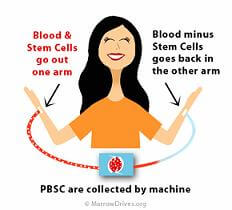
Your stem cells could save the life of a stranger. While being an organ and tissue donor has long held the promise of helping others, a (relatively) new kind of donation could let you save someone with much less fuss. Periphery blood stem cells (PBSC) can be harvested in much the same way you donate blood plasma but they have the potential to treat patients with leukemia and other serious illnesses. Rather than facing minor surgery as traditional bone marrow donors, those who give PBSC will only need to receive a few shots and spend a few hours at a blood donation center. The risks for the donor are extremely low. Organizations in the US and all over the world are raising awareness for PBSC and urging the public to join a registry for bone marrow and PBSC donors. Chances are, your stem cells could save a life with much less work than you ever dreamed. Check out the videos below to see more about the PBSC donor process and hear about one of its many remarkable success stories.
We often discuss the benefits of stem cell therapies in the future tense. Rightfully so, every day research reveals another method in which these valuable cells could help treat ALS, heart disease, cerebral palsy, or some other life threatening malady. The truth is, however, that while stem cells have the potential to save many more lives in the future, they already represent a proven technique for saving lives now. As with bone marrow, stem cells have to be properly matched when donated to strangers. Once such a match is made, though, PBSC can treat a number of different blood based illnesses.
It really is very simple: A donor gets registered, and then, sometimes years later, is contacted to make a PBSC donation. After a few days of special injections (filgrastim) to move stem cells from the marrow to the periphery blood, donors simply have to undergo a blood filtering process to harvest the stem cells. After giving PBSC, you can go back to normal activity in one to two days. Side effects from the filgrastim are generally mild, and there’s no surgery. It seems too easy:
Now that PBSC donation drives have been underway for many years, it’s easy to find success stories. This one from from Tampa Bay features a young mother saving someone else’s one year old child. Not enough for you? You could check out this Boston area college student who saved a young boy through PBSC donation. If you need more there are YouTube channels full of these tales.
The truly tragic thing is that no matter how many people have been saved through a marrow registry there are still many more waiting to be helped. The internet is awash with heart wrenching public announcements seeking donors for ill family members. You can help. Organizations like the National Marrow Donor Program are trying to raise awareness of the needs for bone marrow and PBSC donors. Their Be The Match Registry will mail you a kit so you can send in a DNA sample for free (though they will ask for a contribution to help cover their costs). They can also help you find a local drive to get registered in the US. For our neighbors all over the globe, Bone Marrow Donors Worldwide maintains a list of marrow registries. In the beginning, all it takes is a little time and a cotton swab rubbed against your cheek. You may never be called upon. Those that do become donors, however, will be helping bring the promise of stem cell technologies to those that need them today. The future is going to be full of amazing things, you could help someone live long enough to see it.
[image credit: MarrowDrives.org]
[source: National Marrow Donor Program, Bone Marrow Donors Worldwide]


